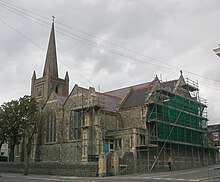St George's Church, Brighton
| St George's Church, Brighton | |
|---|---|
Chichester | |
| Deanery | Rural Deanery of Brighton |
| Parish | Brighton, St George with St Anne and St Mark |
| Clergy | |
| Vicar(s) | Revd Andrew Manson-Brailsford |


St George's Church is an
History
Thomas Read Kemp, born in 1782 in
The Busby–Wilds partnership had also been responsible for building the
Construction work continued throughout 1824 and 1825. The church opened on 1 January 1826, two days after it was consecrated by the Bishop of Chichester. The final cost was £11,000.[4]
By 1831, Kemp had sold his interest in the church to
St George's had been parished since 1879. The Diocese of Chichester considered closing the church in 1962, but the congregation contested the decision and the threat was lifted. The parish later absorbed that of St Anne's Church in nearby Burlington Street, whose congregation was in decline; it was closed and demolished in 1986.[7] In 1986, St Mark's Church was also closed and officially made redundant,[8] and its parish was also amalgamated with that of St George. The building is now the chapel of St Mary's Hall, an independent school.[8]
Architecture

Busby designed St George's Church in a Neoclassical style, with simple clean lines and strong symmetry.[4] The exterior consists of yellow brick with some stucco work, regularly spaced tiered pairs of round-headed windows, and a deep cornice with no ornamentation. The western face, where the entrance is situated, has Ionic columns and pilasters on each side of the door, and a central tower topped by a cupola with a small cross.[4] Clock faces were added on each side soon in 1840.[4][5] Inside, there are galleries at the northern, southern and western sides, reached by curved staircases. There was a three-tier pulpit in front of the reredos at the eastern end, and the organ, by the J.C. Bishop & Son organ builder firm, was initially inside the western gallery.[4][9]
After Revd James Anderson became curate of the church in 1828, his close association with
After it was acquired by the congregation and placed in trust, £11,050 was spent on large-scale alterations to the church.[11] A chancel was added at the eastern end, with a new window in the eastern wall; the reredos was replaced with a larger version; the organ was moved again, into a more conventional position in the south gallery; and both the north and the south galleries were rebuilt at their eastern ends to align with the chancel extension.[6] All of the seating was replaced, increasing the capacity to 1,300.[11]
The church today
St George's was a chapel of ease until 1879, when it was given its own parish. In its present form, incorporating the former parishes of St Anne and St Mark, this covers a large area of eastern Brighton, including the whole of Kemptown, parts of Whitehawk, Brighton Marina and Roedean School.[12]
The church has a community centre at which various groups meet regularly,
St George's also acts as one of Brighton's largest venues for alternative and folk music concerts.[1]
See also
Notes
- A Dale 1989 and the St George's Church website incorrectly identify Peel's name as Lawrence.
References
- ^ a b "St George's Church, Brighton". St George's Church website. St George's Church. 2007. Retrieved 17 December 2012.
- ^ Historic England. "Church of St George the Martyr, Brighton (1380852)". National Heritage List for England. Retrieved 18 January 2008.
- ^ Dale 1989, p. 42.
- ^ a b c d e f g Dale 1989, p. 43.
- ^ ISBN 1-869865-03-0.)
{{cite book}}: CS1 maint: others (link - ^ a b c Dale 1989, p. 45.
- ^ Dale 1989, p. 47.
- ^ a b "The Church of England Statistics & Information: Lists (by diocese) of closed church buildings. Diocese of Chichester" (PDF). Church of England. 21 February 2011. Archived from the original (PDF) on 16 May 2012. Retrieved 5 November 2020.
- ^ a b Dale 1989, p. 44.
- ^ "The History of St George's". St George's Church website. St George's Church. 2007. Retrieved 17 December 2012.
- ^ a b Dale 1989, p. 46.
- ^ "Parish Information: St. George with St. Anne and St. Mark, Brighton". A Church Near You website. Oxford Diocesan Publications Ltd. 2007. Retrieved 14 January 2008.
- ^ "Crypt Community Centre". St George's Church website. St George's Church. 2007. Retrieved 17 December 2012.
- ^ "Crypt Café". St George's Church website. St George's Church. 2007. Retrieved 17 December 2012.
- ^ "My Brighton and Hove" history and photographs of St. George's Church
Bibliography
- Dale, Antony (1989). Brighton Churches. London: Routledge. ISBN 0-415-00863-8.
External links
 Media related to St George's Church, Kemptown, Brighton at Wikimedia Commons
Media related to St George's Church, Kemptown, Brighton at Wikimedia Commons








